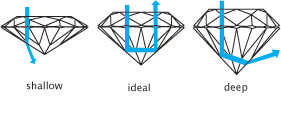Diamond cutting can be traced back to the mid 1300s when European and Indian gem cutters first began to cut and shape rough diamonds. Since that time, there have been many cutting methods identified and published.
Of the 4Cs, Gemologists believe that cut has the greatest influence on a diamond's beauty. Diamonds have a unique ability to effectively manipulate light. This unique quality can only be realized with an extremely high level of accuracy during the cutting and polishing process. Where nature dictates the uniqueness of color and clarity, humans affect the cut. While cutting diamond rough, cutters must not only consider the proportions of a diamond, but also the craftsmanship of overall symmetry and polish as well.
A diamond's brilliance comes from light entering the crown and reflecting from one facet to another and returning back out the crown. A diamond that is cut too shallow or too deep will not reflect light properly and the diamond will not be as brilliant as a diamond with an excellent cut.
Search Loose Diamonds
How a Diamond Handles Light

GIA & Diamond Cut
In early 2005, after more than 15 years of research and testing, the Gemological Institute of American (GIA) introduced a diamond cut grading system for round brilliant shaped diamonds in the D-Z color range. Starting in January 2006, the new cut grades ranging between excellent and poor were added to all GIA diamond certificates (aka plot). Each cut grade represents a range of proportions and diamond appearances each of which have an impact to the characteristics of that grade.
To achieve the cut grading system, GIA calculated the cut results for 38.5 million proportion sets based on the evaluation of seven components. The first three, which were related to appearance were brightness, fire, and scintillation while the second four, weight ratio, durability, polish, and symmetry were related to the overall craftsmanship.
To understand all aspects of the diamond anatomy, click on the GIA link below:
http://www.diamondcut.gia.edu/05_diamond_anatomy.html
To understand cut grades and our suggested guidelines for round brilliants and fancy shaped diamonds, please read our links to "Learn about diamond shapes" on the right hand side of this page.
Click here to learn more about grading and the proportions for Round Brilliant Cut DIamonds 
GIA certificates issued before 2006
GIA certificates issued before 2006 do not display cut grades. Until that time, the term "Ideal" cut was considered the best cut for a round brilliant cut diamond. The GIA study concluded that many combinations or parameters made for an equally efficient cut and in some cases certain ideal parameters were inferior to the GIA excellent cuts.
We understand picking out the perfect diamond can be tricky. Please do not hesitate to call us and speak with a trained sales associate at 1-800-979-1910 with any questions you may have.
 Learn about Diamond Clarity
Learn about Diamond Clarity 
 Learn about Diamond Color
Learn about Diamond Color 
 Learn about Diamond Carat Weight
Learn about Diamond Carat Weight 
 What is our Conflict Diamond Policy?
What is our Conflict Diamond Policy?